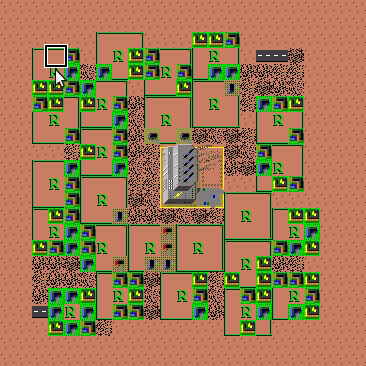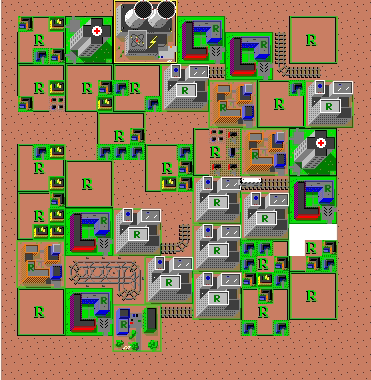-
Notifications
You must be signed in to change notification settings - Fork 168
New issue
Have a question about this project? Sign up for a free GitHub account to open an issue and contact its maintainers and the community.
By clicking “Sign up for GitHub”, you agree to our terms of service and privacy statement. We’ll occasionally send you account related emails.
Already on GitHub? Sign in to your account
Porting to gtk3 / Playing with a neural network #86
Comments
|
Holy shit!!! Mind=blown. I'm sorry I missed this first time around, but just discovered and read your wonderful paper: |
|
The closest thing I came to putting AI into SimCity was integrating Joe Strout's and Jeff Epler's and Jez Higgins Python version of Eliza with the micropolis-online chat window. ;) |
|
In gym-city/notes/notes, you asked: is there any point at which continuous strips of road become worthwhile? Or will the agent be able to effectively maximize population without roads? |
|
And on the topic of traffic and dynamic routing and cellular automata, have you seen Dave Ackley's long term visionary work on the Moveable Feast Machine, and the amazing Distributed City Generation rule that his student Trent R. Small developed, "using bottom up distributed robust-first computing principles"? This paper explains how it dynamically routes traffic to its destination by flowing information about zones down sidewalks towards intersections! |
|
The Moveable Feast Machine is capable of a wide variety of behaviors, it's not just for generating cities, but especially good at randomly moving and diffusing particles around, and simulating biological processes. It's like a cellular automata, but different: designed to do many things traditional cellular automata can't do very easily or at all, like running robustly on the massively parallel but failure prone borg starships and gray goo nanobots of the future. |
|
Robust-first computing: Demon Horde Sort (full version) Intercellular Transport in the Movable Feast Machine Programming the Movable Feast Machine with λ-Codons Object Classification in the Movable Feast Machine |
|
Thank you for this info and these links! The Reverse Diagrams are very helpful. I'm guilty of treating the game as a bit of a black box while throwing AI at it -- typical AI guy behavior. (Played a lot of SC4 growing up but started blindly hacking the reinforcement learning loop as soon as I found this code.) I wonder if the fact that I jacked the speed setting up quite aggressively is kind of eclipsing the usual growth rate benefit that would result from traffic. I wasn't familiar with the Moveable Feast Machine, but wow -- these sent me down a Dave Ackley youtube rabbit hole. I will have to play around with the code. The Distributed City Growth rule in particular is fascinating. I've long dreamt of a differentiable, cellular-automaton-based city sim, and this seems quite close to the latter at least. (Not sure if the "differentiable" part is worth it -- I guess I was thinking "learnable/evolvable game mechanics!" but there may be other ways to go about that.) Something my advisor and I have been discussing for a while is the possibility of training a diverse population of SimCity-playing agents. Each agent would be a little convolutional neural network (i.e. a neural cellular automaton), whose weights are evolved using quality-diversity methods to build different kinds of cities. The hope is that this would allow us to (somewhat) methodically explore the space of cities afforded by the game's mechanics and engage with its politics (and/or quirks). Is it possible to maintain high population without traffic (or employment)? To what extent can we get away with heavy pollution? What do the most profitable cities look like? etc. Regarding M1 Macs and Tensorflow: I've run the code on a Mac, and a previous version used tensorflow, though I've since switched to a different RL training loop that uses pytorch. Still, this loop was originally a port of OpenAI's stable-baselines code (in tensorflow), so it shouldn't be too painful to make it compatible in theory. I just recently got an M1 Macbook. Working toward some deadlines next week, but after those I'll see if I can get something running on the Mac with GPU acceleration. |
|
Those are good ideas about training agents to edit the map. It parallels my thoughts about how to refactor SimCity into a multi player game in which different players have different roles, like driving the bulldozer around, driving a road paving machine, driving house building machines along the roads, and programming robots to help you build and maintain your city. You could recast the city editing tools as "vehicles" or agents (like the helicopter that finds heavy traffic or puts out fires or chases criminals, or a train that delivers building supplies for other robots to deploy), and both players and AIs could learn to drive them around (using a more atari-like interface, that's easier for an ai to learn and much more constrained and focused that full-powered free-form map editing). Robot Odyssey meets SimCity! See Alan Kay's comments on Robot Odyssey: Here are some links related to those ideas: This is a summary I wrote of one of Will's talks that you might find interesting: Will Wright on Designing User Interfaces to Simulation Games (1996) https://donhopkins.medium.com/designing-user-interfaces-to-simulation-games-bd7a9d81e62d And here's an illustrated transcript and a video of a talk I gave about applying ideas from Constructionist Education to Micropolis: Micropolis: Constructionist Educational Open Source SimCity Here's a video demo of the Python web server / Flash browser client based Micropolis, that shows the plug-in PacMan agent and Church of Pacmania zone scripted in Python: https://www.youtube.com/watch?v=8snnqQSI0GE&ab_channel=DonHopkins Here's an outline I wrote about the stuff I did and stuff I wanted to do, to make a multi player Python scriptable SimCity/Micropolis using AMF and OpenLaszlo. At the end there are some "Future Plans" that touch on applying the ideas of Constructionist Education to teach language and writing and group collaboration skills! Like using collaborative SimCity as a communication medium and discussion tool for kids to help each other learn by writing proposals, discussing, campaigning, voting on, implementing, and journalising them. https://github.com/SimHacker/micropolis/blob/master/PROGRESS.txt Future plans. https://github.com/SimHacker/micropolis/blob/master/laszlo/micropolis/TODO.txt Saving and Structuring Cities and Scenarios Each city has a "parent" field pointing to the city that it was loaded from. Are city save files mutable? Ideally, no, so parent links will point Each user is initially allowed one mutable "leaf" city. They can Unify the identification of scenarios, anonymous generated cities, and Multi Player Chat interface. Language translation. Enters select their language from a menu. Chat visibility. Channels. Visual/video chat. Virtual friends. Speech synthesis. Connect games to real-world problems. Write a letter to your congressman from within the game, about a TODO for Education: TODO for Programming: |

If anyone could lend a hand porting this to python3/gtk3, I've made considerable progress here: https://github.com/smearle/gym-micropolis/tree/master/micropolis-4bots-gtk3, at the service of an OpenAI gym environment enabling the training of city-building bots. There are just some glitches in the gui that need to be worked out.
These bots store their own internal representation of the game map (via the engine.getTile(x, y) function). The gtk3 port above, if initialized with a bot, (via pyMicropolis.gtkFrontend.main.train(bot)), will notify the bot of any human-player actions executed via the gui, so that it can update its own map-representation and respond accordingly. See below for a simple example of interactive inference with from early on in training:

The networks I'm using are trained using actor-critic (A2C), and are made up entirely of convolutional layers (making them too cumbersome for ACKTR, since Kronecker factorization seems to need to jump through extra hoops to deal with convolutions (?)). Passing activations repeatedly through a single convolutional layer seems to result in performance that is at least on par with - and sometimes apparently better than - that of the same network, sans repeated passes. And finally, each layer of activation is the same width and height as the original input feature-map (where each 'pixel' of the image is a tile of the game map).
By adopting a convolution-only architecture, we pave the way for scalability to larger map sizes (since the action space is the map itsef, with build-actions for channels, a linear layer between it and the input would grow exponentially with map size). By using recursive (repeated) convolution, we allow distant activations on the feature-map to affect one another, again at minimal computational cost. And by making our hidden activations occur "on the map," we can think of our network as executing a kind of non-discrete Conway's game-of-life to determine its next build, or of letting activations flow spatially through the map itself, which has a certain appeal (though I can't help but feel that the notion of a compressed map, for more abstract, high-level spatial planning, might also be invaluable in this problem space...).
Another such network, a bit further along, without my bullying it:

If anyone has a spare gpu, I'm currently using a pytorch port of the OpenAI baselines repo for training: https://github.com/smearle/pytorch-baselines-micropolis. I'm very interested in exploring the possible space of neural architectures that lend themselves well to this environment, since it seems to foreshadow a more general game-playing paradigm which takes for input the gui-as-image, and outputs something like an equal-size gray-scale image, with pixel intensity corresponding to mouseclick-likelihood, for example.
In the current context, however, I want to make these agents as interactive as possible - the player should be able to make whatever builds they desire, and have the bot complement their design to optimize for some combination of factors (population, traffic, happiness, pollution, etc.). The player should be able to control these bots from the gui (stop/starting them, setting their optimization-goals), and confine their building area to subsections of the map. To this end, any help completing the port to gtk3 would be appreciated. Thanks :)
The text was updated successfully, but these errors were encountered: